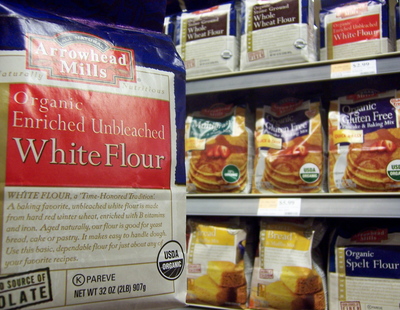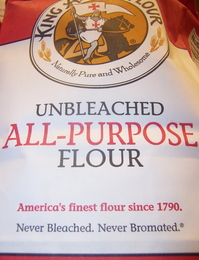Unbromated flour: please label

Is this flour bromated? Only if you know that organic practices prohibit bromation.
Corinna Borden | Contributor
Food labeling is helpful immediately. The more information about what you are putting into your body the healthier choices you can make. No one is ever going to force feed you an ice cream sundae. You choose to ingest those calories and sugar with your eyes wide open and sometimes the decadent nature of the treat can add to the pleasure of eating.
Which brings me to labeling unbromated flour.
Flour? Really?
Really.
Flour or gluten is in nearly everything we eat (just ask someone with Celiac Sprue disease). As a mainstay of our Western diet, it invites a closer inspection. The buzz words on the street for flour are "unbleached and unbromated." Most people I have asked do not know what bromation is.
I learned about bromation when I worked for Zingermans Bakehouse, if you already know the facts, please excuse me for this brief recap.
You harvest wheat and you grind it into flour, good. For the first couple of hours that flour can form beautiful gluten, which are protein strands that occur when you add mechanical energy, kneading, to flour and water. After those initial hours the enzymes go wonky in the flour and will not properly form gluten. However, if you age the flour for a few weeks or so it settles down enough to form gluten and baking can commence.
As we all know, time is money. Some smart person (there is a dearth of information about this on the internet) realized that if you pump potassium bromide onto the flour it artificially ages it. Therefore the flour can be used for baking without waiting for it to age. Voila! Money saved!
Meanwhile the UK banned the use of bromide in food products nearly 20 years ago, and Canada did the same thing 15 years ago. In 1986, California passed Prop 65 (ironically, the same rule that mandates the rule of carcinogen signs in airports) and many brands (like Pepperidge Farm, Arnold, Pillsbury, and Entenmanns) switched to an unbromated flour because otherwise their packages would need a cancer warning sign when sold in California.

King Arthur flour is labeled as "never bromated."
Corinna Borden | Contributor
There are very few flour labels that say unbromated, or “aged naturally.” In my small sample size of reading ingredients in products made with flour (crackers, cereal, bread, pasta, etc), I could find no mention of unbromated flour. Unbleached flour was mentioned, enriched flour was mentioned, but there was nothing about unbromated.
Finally, I learned from a woman at the supermarket (curious as to why I was taking pictures of flour bags) that bromide is used to increase the density of vegetable oil, which then ends up in citrus flavored soft drinks (look for BVO in drinks like Mountain Dew).
I am not going to get into the science of whether or not bromide is a carcinogen. I want to know what I am putting into my body so I can choose with my eyes wide open. I would like bromated flour to be labeled.
Drop me a line! Check out my website! Read my book! Post a comment and start the conversation rolling!


Comments
david
Tue, Mar 2, 2010 : 12:26 a.m.
you still have to check labels in wholefoods or any other health food store
Corinna Borden
Thu, Jan 7, 2010 : 3:22 p.m.
Wolverine3660, thank you for the link to the posting - I appreciate it. The amount of information about what is in our food can be debilitating and overwhelming. (I don't think you were insinuating anything, I appreciate learning something new, and conversing with you, smile.)
JAM
Thu, Jan 7, 2010 : 10:30 a.m.
I just looked up "potassium bromide" on Wikipedia... does this scare anybody else? Yikes. I feel much better now about what I pay for King Arthur! Read this -- Potassium bromide (KBr) is a salt, widely used as an anticonvulsant and a sedative in the late 19th and early 20th centuries. Its action is due to the bromide ion (sodium bromide is equally effective). Potassium bromide is presently used as a veterinary drug, as an antiepileptic medication for dogs and cats. Under standard conditions, potassium bromide is a white crystalline powder. It is freely soluble in water. In a dilute aqueous solution, potassium bromide tastes sweet, at higher concentration it tastes bitter, and when most concentrated it tastes salty to humans (these effects are due mainly to potassium ion; sodium bromide merely tastes salty at all concentrations). In high concentration potassium bromide strongly irritates the gastric mucous membrane, leading to nausea and sometimes vomiting (again this effect is typical of all soluble potassium salts).
Wolverine3660
Thu, Jan 7, 2010 : 6:13 a.m.
Corinna- here is the link to that article: http://www.annarbor.com/passions-pursuits/a-new-eating-disorder/
Wolverine3660
Thu, Jan 7, 2010 : 6:11 a.m.
Corinna- I wasnt insinuating that your article would lead to orthorexia nervosa. One of the other AnnArbor.com bloggers had a short post about this condition a couple of months back.
Corinna Borden
Wed, Jan 6, 2010 : 4:23 p.m.
Wolverine3660, thank you - I did not know the term Orthorexia Nervosa. I am sorry about your friends.
Wolverine3660
Wed, Jan 6, 2010 : 10:01 a.m.
on the other hand, one can also go overboard worrying about carcinogens and other chemicals in our foods,and then get diagnosed with a severe case of Orthorexia Nervosa. I have 2 friends that are this way. Unfortunately.
susan
Wed, Jan 6, 2010 : 7:52 a.m.
Just another example of why to shop at the health food store! Thank you for this informative article.